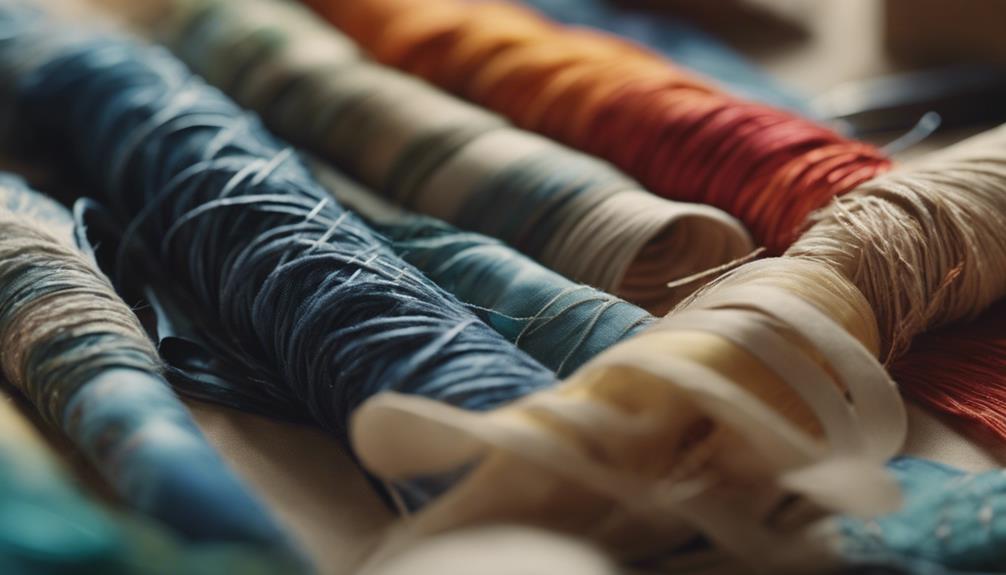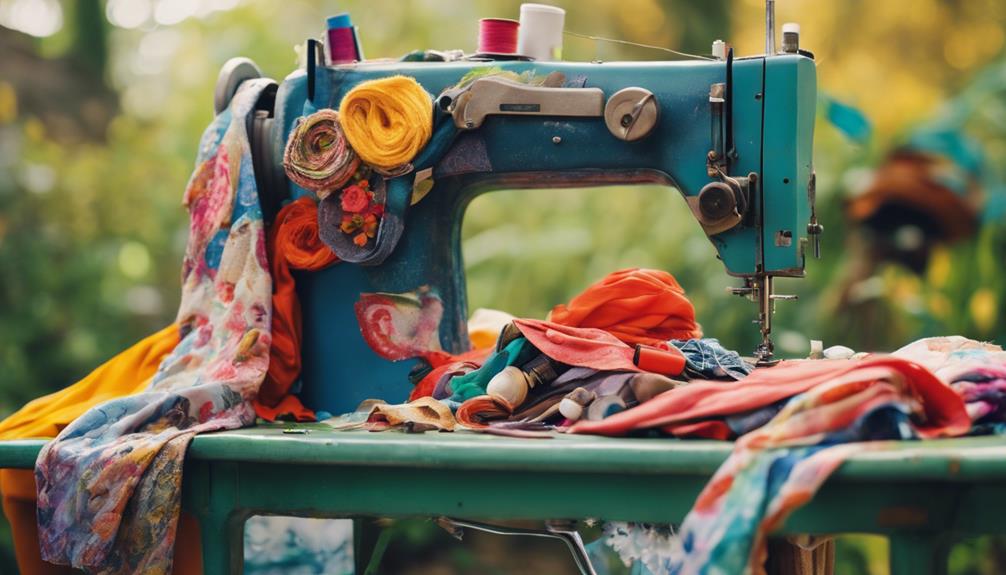Sustainable fashion can endure for several years, often surpassing the lifespan of fast fashion items. By opting for high-quality materials and classic designs, you are investing in longevity. Many sustainable brands emphasize skilled craftsmanship, utilizing recycled fabrics that not only minimize waste but also improve the lifespan of the clothing. In fact, by prolonging the usage of your clothes by just nine months, you can reduce the environmental impact by up to 30%. Prioritizing sustainable pieces over trendy ones helps build a more eco-friendly wardrobe. There is more to learn about how your choices affect both fashion and the planet.
Key Takeaways
- Sustainable fashion garments can last significantly longer than fast fashion, often extending their lifespan by years due to higher-quality materials and craftsmanship.
- Investing in timeless styles rather than trendy pieces promotes longevity, as they remain relevant and wearable over time.
- Extending the use of clothing by just nine months can reduce environmental impact by up to 30%.
- Brands focusing on sustainability often utilize durable materials, including recycled fabrics, which enhance garment lifespan.
Understanding Sustainable Fashion Lifespan
Understanding the lifespan of sustainable fashion means recognizing how quality materials and mindful consumption can greatly extend the life of your garments.
As clothing production doubled in recent years, the environmental consequences have become increasingly apparent, especially with fast fashion. Unlike these disposable items, sustainable fashion focuses on garment longevity, ensuring your clothes last longer and reduce waste.
When you choose sustainable pieces, you're investing in high-quality materials and ethical production methods that can withstand the test of time. Brands committed to sustainability often design garments that can last for several years, or even decades, with proper care.
By extending the use of your clothing by just nine months, you can reduce its environmental impact by up to 30%.
Additionally, opting for timeless and versatile styles rather than chasing fleeting trends will help you build a sustainable wardrobe that remains stylish over time. This conscious choice not only enhances your personal style but also promotes a shift away from the throwaway culture.
Ultimately, understanding sustainable fashion's lifespan encourages you to make informed decisions that benefit both your wardrobe and the planet.
Factors Affecting Durability

Several key factors influence the durability of sustainable fashion, impacting how long your garments will last and how they contribute to a more eco-friendly wardrobe.
The quality of materials used is essential; higher-quality fabrics from sustainable brands tend to last considerably longer than those commonly found in fast fashion, which often prioritize disposability over longevity.
When you choose garments made from innovative, sustainable fabrics—like those crafted from recycled materials—you not only enhance durability but also help reduce waste in the industry.
Furthermore, sustainable brands often emphasize craftsmanship and ethical production methods, resulting in pieces that can withstand wear and tear better than their low-quality counterparts.
It's essential to recognize that extending the lifespan of your clothing by just nine months can cut its environmental impact by about 30%.
Consequently, investing in timeless pieces instead of trend-driven items is critical. By doing so, you're not just contributing to a sustainable wardrobe; you're also ensuring that your clothing remains durable, practical, and stylish for years to come.
Consumer Influence on Longevity

As consumers increasingly prioritize sustainability in their shopping habits, their choices play an important role in determining the longevity of fashion items. You have the power to influence the market greatly by opting for quality over quantity.
The average lifespan of garments has plummeted by 50% in recent decades, highlighting the significance of selecting pieces that endure. By extending the use of clothing by just nine months, you can reduce its environmental impact by 30%.
Yet, only 15% of consumers currently recycle used clothing, signaling an opportunity for you to make a difference. If you embrace sustainable fashion practices, you can encourage brands to produce longer-lasting products.
Research shows that 71% of millennials, like you, prioritize sustainability, which can create a ripple effect in the industry.
Adopting a minimalist closet approach allows you to focus on fewer, high-quality items, promoting a sustainable fashion cycle and reducing overall consumption. Your consumer influence is crucial in shaping a future where sustainable fashion thrives and longevity is the norm.
Choose wisely, and together, we can transform the fashion landscape.
Innovations Extending Clothing Life

Innovative approaches in sustainable fashion are reshaping how you think about clothing longevity, with advancements that not only enhance durability but also lessen environmental impact. These innovations are essential for extending clothing life and promoting a more sustainable future.
Here are three key innovations you should know about:
- Recycled Materials: Brands like Patagonia use polyester fleece made from recycled plastic bottles, creating durable garments that divert waste from landfills.
- Repair and Upcycling Programs: Many companies now offer services to repair or upcycle your clothing, encouraging you to extend its life instead of tossing it out. This promotes a circular economy and fosters mindful consumption.
- Eco-Friendly Fabrics: Advances in biodegradable materials allow you to enjoy stylish, functional garments while minimizing their overall lifecycle impact.
The Role of Recycling

When you think about recycling in fashion, it's essential to understand how it can reshape the industry.
Recycling initiatives not only help reduce waste but also offer significant benefits for the environment and economy.
However, you'll also see that there are challenges in the recycling process that need addressing for these initiatives to succeed.
Recycling Initiatives Overview
Recycling initiatives play an essential role in transforming the fashion industry's waste crisis into a sustainable opportunity for resource recovery and environmental protection. Unfortunately, less than 1% of clothing materials are currently recycled, and about 60% of produced garments end up in landfills or incinerators within a year.
To address this issue, here are three key aspects of recycling initiatives that you should be aware of:
- Consumer Participation: Although many brands offer recycling programs, only 15% of consumers actively return their old clothing. Your involvement is vital to improving these initiatives.
- Quality of Materials: The poor quality of discarded clothing, especially synthetic fibers, poses a significant challenge. High-quality recycling processes can help recover valuable resources, but they require better quality materials.
- Future Projections: The fashion industry is projected to face an alarming increase in fashion waste, reaching 148 million tons by 2030. Effective recycling initiatives are vital to mitigate this looming crisis.
Benefits of Garment Recycling
Garment recycling offers significant benefits by reducing waste, conserving resources, and minimizing the environmental impact of the fashion industry.
When you recycle textiles, you help decrease the staggering 60% of clothing that ends up in landfills within a year. This not only saves valuable space but also prevents the pollution caused by incineration.
Through effective recycling initiatives, you can contribute to a circular economy, where old garments are transformed into new materials, reducing the need for resource-intensive production.
Challenges in Recycling Process
The complexities of the recycling process pose significant challenges for effectively managing textile waste in the fashion industry. Less than 1% of clothing materials are recycled, leading to a staggering annual loss of $100 billion.
Here are some primary challenges you should know about:
- Mixed Materials: Many garments use various fabrics, making it tough to separate and repurpose them effectively.
- Eco-friendly Fabrics: While marketed as sustainable, these materials often don't decompose in landfills, complicating recycling efforts even further.
- Limited Consumer Participation: Only 15% of consumers actively recycle their used clothing, which hinders recycling initiatives.
To tackle these issues, we need innovations in recycling technology. Traditional methods just can't keep pace with the fast fashion industry's demands, resulting in an overwhelming amount of textile waste.
If we want sustainable fashion to thrive, it's vital to improve recycling processes and encourage consumers to participate actively. By addressing these challenges, we can work towards a more eco-friendly fashion landscape that truly values sustainability and resource conservation.
Myths About Sustainable Durability

You might think that sustainable fashion equals low durability, but that's a common misconception.
In reality, many sustainable brands focus on high-quality materials and craftsmanship, leading to garments that last much longer.
It's important to explore how quality and perception shape your understanding of sustainable fashion's durability.
Misconceptions About Durability
Many people mistakenly think sustainable fashion sacrifices durability for eco-friendliness, but in reality, these pieces often outlast their fast fashion counterparts.
Here are three key points to reflect on:
- Quality Over Quantity: Sustainable brands prioritize quality and craftsmanship, resulting in garments that can endure wear and tear better than cheaper alternatives. This focus leads to a longer lifespan for your clothes.
- Material Resilience: Contrary to common belief, sustainable fabrics like organic cotton and recycled polyester are designed to be just as durable as conventional materials. You won't be compromising on strength when you choose eco-friendly options.
- Timeless Design: Many sustainable fashion pieces emphasize timeless aesthetics, meaning they won't go out of style quickly. This encourages you to keep and wear your clothes longer, reducing the need for frequent replacements.
Quality Vs. Perception
Misunderstandings about sustainable fashion often cloud perceptions of its durability, leading consumers to underestimate the quality and longevity of eco-friendly garments. Many people mistakenly believe that sustainable clothing is less durable, but this couldn't be further from the truth.
Sustainable brands frequently prioritize high-quality craftsmanship, creating pieces that can outlast fast fashion items, which are typically worn only a few times before being discarded.
When you invest in sustainable fashion, you're not just purchasing a garment—you're choosing longevity. Research shows that extending the lifespan of clothing by just nine months can reduce environmental impact by up to 30%.
Plus, contrary to the belief that sustainable fashion lacks variety, innovative designs utilize recycled materials and advanced techniques, offering stylish and durable options for every taste.
It's also important to recognize the cost-effectiveness of quality garments. While fast fashion items may seem cheaper upfront, their lower quality means you'll likely need frequent replacements.
Future of Sustainable Fashion Practices

The future of sustainable fashion practices hinges on innovative materials and production processes that prioritize environmental responsibility and circular economy principles.
As you explore this evolving landscape, you'll notice significant shifts toward ethical fashion and slow fashion that can reshape your shopping habits and choices.
Here are three key trends to keep an eye on:
- Innovative Materials: Expect brands to adopt biodegradable, recycled, and upcycled materials that reduce waste and environmental harm. This innovation makes sustainable clothing more appealing and accessible.
- Consumer Collaboration: As 71% of millennials prioritize sustainability, you'll likely see increased communication between you and brands. This collaboration fosters greater transparency, pushing companies to adopt ethical practices that meet your expectations.
- Circular Economy: More brands will embrace circular economy principles, focusing on designing products for longevity and recyclability. This shift not only minimizes waste but also encourages you to invest in quality pieces that last.
Frequently Asked Questions
Does Sustainable Fashion Last Longer?
Yes, sustainable fashion lasts longer. You'll find high-quality materials and timeless designs, which contribute to durability. Investing in versatile pieces means you'll wear them for years, reducing your overall environmental impact while enhancing your wardrobe.
Do People Really Care About Sustainable Fashion?
You might think people don't care about sustainable fashion, but studies show 71% of millennials prioritize it in their shopping. As awareness grows, more consumers actively seek out ethical brands and demand transparency.
Does Sustainable Fashion Really Work?
Yes, sustainable fashion works by prioritizing quality, durability, and eco-friendly materials. You'll reduce your environmental impact and save money in the long run, proving that thoughtful choices in fashion can create meaningful change.
How Long Should You Keep Clothes to Be Sustainable?
If you keep a high-quality jacket for five years instead of replacing it every season, you drastically reduce waste. Aim to retain clothes for at least three years to make a sustainable impact and minimize environmental harm.
Is the Longevity of Sustainable Fashion Related to Its Environmental Impact?
The longevity of sustainable fashion and the environment are closely intertwined. By creating clothing with eco-friendly materials and ethical production methods, sustainable fashion reduces its environmental impact. This, in turn, helps to preserve natural resources and minimize pollution, ultimately contributing to a more sustainable future for the fashion industry.
Conclusion
In the grand tapestry of sustainable fashion, longevity isn't just about durability; it's about weaving a story that transcends time.
When you choose wisely and embrace innovative practices, you're not just investing in clothing but in a legacy of mindful consumption.
Remember, it's not just what you wear; it's how you wear it.
As you step into the future, every choice you make can turn fleeting trends into cherished heirlooms, creating a wardrobe that whispers sustainability.









